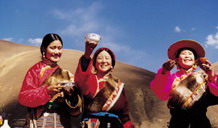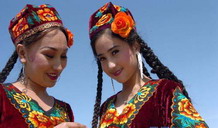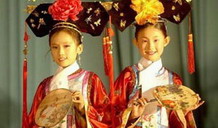Mongolian Folk Dance
 Dance is always closely connected with song. According to history, the earliest dance in Inner Mongolia was named tage (stamping feet accompanied by singing). The pastoral life and the work of herdsmen became the source for dance there. The male dances in Inner Mongolia are rugged, lionhearted, and full of power. The famous male dances are the horse and sword dance, the hawk dance, and the roughrider dance. Every movement in the dance shows the audience the beauty in power, virility and work ethic.
Dance is always closely connected with song. According to history, the earliest dance in Inner Mongolia was named tage (stamping feet accompanied by singing). The pastoral life and the work of herdsmen became the source for dance there. The male dances in Inner Mongolia are rugged, lionhearted, and full of power. The famous male dances are the horse and sword dance, the hawk dance, and the roughrider dance. Every movement in the dance shows the audience the beauty in power, virility and work ethic.
In the powerful dance, the hawk and the horse are the two most important roles. Genghis Khan looked on the hawk as the God of War, which could guarantee him victory. Now, people still regard the hawk as a symbol of victory. Wrestlers today go onto the racing field imitating the hawk jump, which, they believe, can enhance their confidence. In some areas, the ceremony of "jumping white hawk" is held to cure uncommon diseases of people.
The horse is essential to nomadic tribes in Inner Mongolia. Since horses are intuitive of human feeling and can know the way through boundless prairies and help their owners out of trouble during war, they are loyal friends to nomadic tribes. Consequently, horse images are frequently found in folk dances on the pasture lands. Herdsmen do not simply imitate the appearance of a horse. They put passion into portraying horse characteristics. Through arm, shoulder and body movements, they reveal the valiant and heroic bearing of horse riders and various horse images.
There are also female dances in Inner Mongolia. The most famous are the Jinai dance (milking dance), the Caihong dance (rainbow dance), the Zhongwan dance (bowl dance), the Kuaizi dance (chopsticks dance), and the Andai dance. There are also many stories about these folk dances for women.
The Andai dance, for example, has many beautiful stories. One of them is this: Andai actually is the name of an ordinary girl, but a serious disease threatened her life. Her father drove the carriage to send Andai to see the doctors, but no doctor could cure her. Her father never gave up and drove the carriage from one doctor to another. Unfortunately, the carriage broke during the long journey. Her father was broken-hearted and crying. Herdsmen from all directions who heard the sad crying went there and calmed the old man. At last, they encircled the father and daughter, and sang and danced to encourage them. When Andai heard the courageous singing and vigorous dancing, her depressed heart was encouraged and her disease was miraculously cured.






